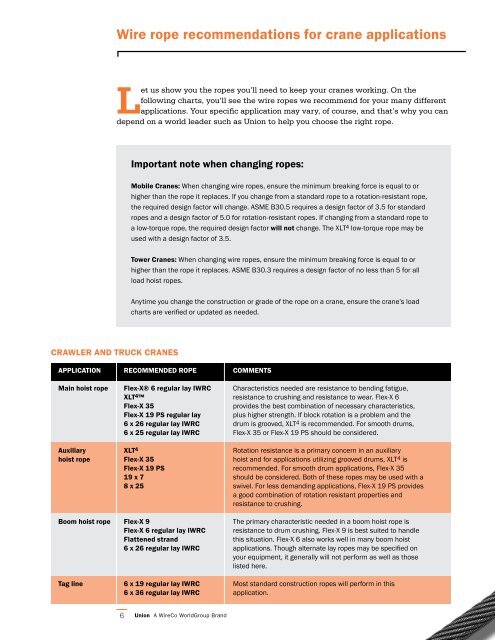Crane User's Guide - Union Wire Rope
Crane User's Guide - Union Wire Rope
Crane User's Guide - Union Wire Rope
Create successful ePaper yourself
Turn your PDF publications into a flip-book with our unique Google optimized e-Paper software.
Crawler and trUCk <strong>Crane</strong>s<br />
wire rope recommendations for crane applications<br />
let us show you the ropes you’ll need to keep your cranes working. On the<br />
following charts, you’ll see the wire ropes we recommend for your many different<br />
applications. Your specific application may vary, of course, and that’s why you can<br />
depend on a world leader such as <strong>Union</strong> to help you choose the right rope.<br />
important note when changing ropes:<br />
mobile <strong>Crane</strong>s: When changing wire ropes, ensure the minimum breaking force is equal to or<br />
higher than the rope it replaces. If you change from a standard rope to a rotation-resistant rope,<br />
the required design factor will change. ASME B30.5 requires a design factor of 3.5 for standard<br />
ropes and a design factor of 5.0 for rotation-resistant ropes. If changing from a standard rope to<br />
a low-torque rope, the required design factor will not change . The XLT 4 low-torque rope may be<br />
used with a design factor of 3.5.<br />
tower <strong>Crane</strong>s: When changing wire ropes, ensure the minimum breaking force is equal to or<br />
higher than the rope it replaces. ASME B30.3 requires a design factor of no less than 5 for all<br />
load hoist ropes .<br />
Anytime you change the construction or grade of the rope on a crane, ensure the crane’s load<br />
charts are verified or updated as needed.<br />
aPPliCation reCommended roPe Comments<br />
main hoist rope flex-X® 6 regular lay iwrC<br />
Xlt 4<br />
flex-X 35<br />
flex-X 19 Ps regular lay<br />
6 x 26 regular lay iwrC<br />
6 x 25 regular lay iwrC<br />
auxiliary Xlt 4<br />
hoist rope flex-X 35<br />
flex-X 19 Ps<br />
19 x 7<br />
8 x 25<br />
boom hoist rope flex-X 9<br />
flex-X 6 regular lay iwrC<br />
flattened strand<br />
6 x 26 regular lay iwrC<br />
tag line 6 x 19 regular lay iwrC<br />
6 x 36 regular lay iwrC<br />
6<br />
Characteristics needed are resistance to bending fatigue,<br />
resistance to crushing and resistance to wear . Flex-X 6<br />
provides the best combination of necessary characteristics,<br />
plus higher strength. If block rotation is a problem and the<br />
drum is grooved, XLT 4 is recommended . For smooth drums,<br />
Flex-X 35 or Flex-X 19 PS should be considered.<br />
Rotation resistance is a primary concern in an auxiliary<br />
hoist and for applications utilizing grooved drums, XLT 4 is<br />
recommended. For smooth drum applications, Flex-X 35<br />
should be considered . Both of these ropes may be used with a<br />
swivel. For less demanding applications, Flex-X 19 PS provides<br />
a good combination of rotation resistant properties and<br />
resistance to crushing .<br />
The primary characteristic needed in a boom hoist rope is<br />
resistance to drum crushing . Flex-X 9 is best suited to handle<br />
this situation . Flex-X 6 also works well in many boom hoist<br />
applications. Though alternate lay ropes may be specified on<br />
your equipment, it generally will not perform as well as those<br />
listed here .<br />
Most standard construction ropes will perform in this<br />
application .


